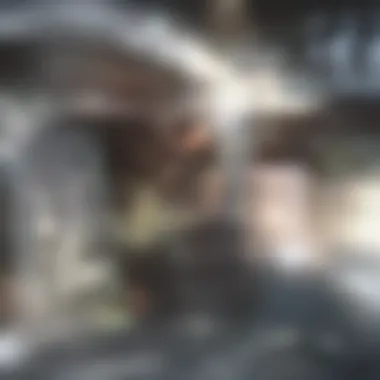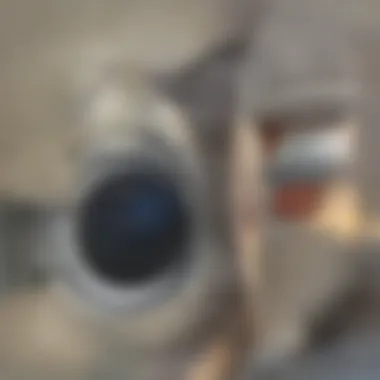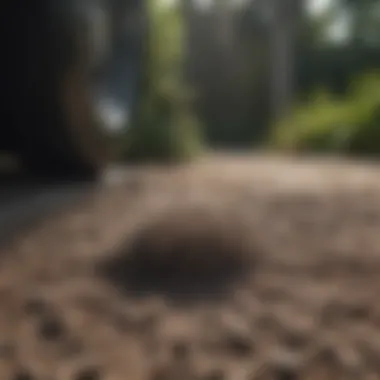Understanding Dryer Lint and Its Environmental Impact


Intro
In our modern homes, appliances like dryers have become essential. However, they produce byproducts that often go unnoticed. One of these byproducts is dryer lint. While it seems benign, it has implications beyond the confines of our laundry rooms. This article seeks to engage with the often-ignored subject of dryer lint, particularly its influence on outdoor spaces. Understanding its composition, hazards, and management strategies can empower homeowners and design enthusiasts to rethink their outdoor environments.
The focus will be on the properties of dryer lint and its effects on the surrounding land. It is a composite material created from fabrics, hair, and dust. When brought outdoors, it poses risks such as potential fire hazards, environmental pollution, and a change in local flora and fauna. Awareness of these issues is crucial, especially as environmental conservation becomes increasingly important.
Through this exploration, we will not only highlight the potential dangers associated with dryer lint but also offer practical management strategies. Our goal is to provoke thought about this common household residue and its hidden impact on our outdoor spaces.
Preface to Dryer Lint
Dryer lint is often dismissed as a trivial byproduct of the laundry process, yet it warrants significant attention for many reasons. Recognizing its impact extends beyond the confines of household chores; it influences our outdoor spaces, environmental health, and even safety. Understanding dryer lint entails more than its casual definition. It sets the stage to comprehend the lifecycle of this material and its, occasionally, unintended consequences. This section serves as the foundation for the discussion surrounding dryer lint, outlining its composition and the critical reasons for being mindful of its presence beyond the dryer.
What is Dryer Lint?
Dryer lint forms during the drying process when fabric and fibers shed from clothing. Every time a load is dried, small particles collect in the lint trap. Although this might seem like a commonplace occurrence, the sheer volume of lint generated can be surprising. For instance, a single load may produce a few grams of lint, accumulating over time to represent a massive quantity in a household's yearly output. Thus, dryer lint is not merely a nuisance, but a composite of micro-particles that carries implications for both home and environment.
Composition of Dryer Lint
The composition of dryer lint varies depending on the types of fabrics washed and dried, yet it generally includes a mixture of:
- Fibers from clothing: The primary constituents of lint are fibers that come from synthetic and natural fabrics. Materials like cotton, polyester, and wool are common.
- Detergent residues: Chemical residues from laundry detergents may also be present, adding another layer of complexity to its analysis.
- Dust and skin cells: These organic materials contribute to the total mass of lint but are often overlooked in discussions about drying byproducts.
Educating oneself about dryer lint and its makeup can unveil the need for responsible management practices, informing homeowners and outdoor enthusiasts alike. Understanding its materials helps in assessing potential impacts on human health and the environment, which is vital for promoting cleaner and safer surroundings.
The Lifecycle of Dryer Lint
Understanding the lifecycle of dryer lint is crucial to grasp its environmental impacts. This topic reveals how lint forms, moves, and affects outdoor spaces. Knowing its lifecycle helps homeowners appreciate the significance of proper dryer maintenance and lint management. This knowledge leads to proactive measures that can minimize risks associated with lint dispersion.
Formation in the Dryer
Dryer lint forms primarily during the drying process of laundry. As wet clothes tumble inside a dryer, fibers from fabrics break loose. These fibers are mostly made up of cotton and synthetic materials, which accumulate in the lint trap. While most of this material gets filtered out, some particles escape into the air. The temperature and air flow within the dryer play significant roles in the formation of lint. If a dryer is overstuffed or not functioning efficiently, more lint is likely to escape into the ducts and outdoors.
- Common causes of lint formation:
- Frequent use of the dryer
- Drying large loads
- The type of fabrics being dried
The lint trap must be cleaned regularly to prevent buildup and reduce the risk of fire. Not only does this maintenance assist with appliance efficiency, but it also minimizes the dryer lint that might escape outdoors.
Dispersion Outside the Home


After formation, lint can easily make its way outside the home. Opening dryer vents leads to air flow that pushes small lint particles out into the environment. Wind can further carry this debris into surrounding areas, leading to accumulation in various outdoor settings.
"The dispersion of dryer lint into outdoor areas can affect local ecosystems and create potential hazards."
Common outdoor considerations include:
- Impact on nearby plant life: Excessive lint may inhibit growth by covering soil or blocking sunlight.
- Hazards for wildlife: Small animals can ingest lint, mistaking it for food. This poses serious health issues for them.
To manage these issues, it is important for homeowners to understand the pathways of lint dispersion. Regular maintenance of dryers and the installation of proper venting systems can significantly reduce the amount of lint released into outdoor spaces.
Environmental Impact of Dryer Lint
The environmental impact of dryer lint is a critical, yet often ignored, aspect that warrants thoughtful consideration. The accumulation of dryer lint can lead to significant ecological issues, as it travels from residential areas into broader outdoor spaces. Recognizing these impacts is essential, not only for sustainability but also for the health of local ecosystems.
Dryer lint is composed largely of natural fibers, but its presence in outdoor settings raises various concerns. From altering soil compositions to affecting water drainage, the implications are far-reaching. By understanding these effects, readers can assess how their dryer use impacts outdoor environments and what steps they can take towards more mindful management.
Ecological Effects
The ecological effects of dryer lint are multidimensional. When dryer lint escapes into gardens or natural habitats, it can change the physical and chemical properties of the soil. This alteration can hinder the growth of native plants, as certain types of lint can absorb moisture or nutrients from the soil. Furthermore, the introduction of foreign fibers may disrupt the habitats of existing ecosystems.
Consider the following points regarding ecological effects:
- Soil Composition: Dryer lint can disrupt the texture and nutrients in soil, making it less hospitable for native plant species.
- Water Drainage: Accumulation of lint can block drainage paths, leading to pooling water and possible erosion issues.
- Microbial Activity: An overload of materials from dryer lint can affect microbial ecosystems, crucial for soil health.
These changes can create a ripple effect, impacting not only vegetation but also insects and other wildlife that depend on those plants for food and shelter.
Potential Hazards to Wildlife
The potential hazards that dryer lint poses to wildlife should not be underestimated. Wildlife will often ingest materials from their environments. If animals consume dryer lint, it can lead to serious health issues. Many species, especially birds, may pick up lint while foraging, mistaking it for nesting materials. This misidentification poses risks, as synthetic fibers commonly found in dryer lint are not biodegradable and can cause internal harm.
Additionally, consider these risks:
- Ingestion: Small animals may consume lint, leading to blockages in their digestive systems.
- Nest Composition: Birds may use lint to build nests, which can trap young birds or cause problems during showers.
- Chemical Contaminants: Some dryer lint could contain traces of chemicals from laundry detergents that may be toxic to wildlife.
"The impact of dryer lint extends beyond the confines of our homes, making it necessary for homeowners to recognize their role in environmental stewardship."
In summary, the ecological and wildlife hazards associated with dryer lint demonstrate the essential need for awareness and proactive management measures. The inclusion of dryer lint in outdoor spaces can have a lasting impact on local ecosystems. It's crucial for homeowners to take these considerations into account when managing their laundry practices.
Health and Safety Considerations


Understanding the health and safety implications of dryer lint is crucial for homeowners and design enthusiasts. Dryer lint, a byproduct of the drying process, can pose various risks. This section highlights two significant areas: fire hazards and health risks arising from outdoor accumulation. Recognizing these risks contributes to better home safety and environmental health.
Fire Risks Associated with Dryer Lint
Dryer lint is highly flammable. When accumulated in dryer vents, it can create a significant fire hazard. Reports show that lint build-up is a leading cause of dryer-related fires. The National Fire Protection Association (NFPA) indicates that dryer fires cause thousands of injuries and millions in property damage annually. It's essential to consider the following factors:
- Blocked Vents: When vents get clogged, air cannot circulate properly. This directly increases heat levels in the dryer.
- Ignition Source: Lint can easily ignite if it comes into contact with hot surfaces or sparks from the dryer.
- Regular Maintenance: Homeowners should routinely clean lint traps and the entire vent system.
"Maintaining clean dryer vents not only enhances fire safety but also improves dryer efficiency."
Health Risks from Outdoor Accumulation
Outdoor accumulation of dryer lint raises health concerns. When lint escapes the dryer, it can settle in yards or community spaces. This not only affects aesthetics but can also influence health negatively. Here are some considerations:
- Allergen Sensitivity: Dryer lint often contains small fibers and pollen, which may aggravate allergy sufferers.
- Chemical Residues: Lint can retain traces of detergents or softeners, which may pose health risks to pets or wildlife that come into contact with it.
- Environmental Impact: Accumulated lint can affect the local ecosystem, potentially harming local flora and fauna.
The connection between dryer lint and health considerations is not widely discussed, yet it holds significance. Being aware of these health risks allows homeowners to take preventive actions, ensuring safer outdoor environments.
Dryer Lint Management Strategies
Dryer lint management is essential for homeowners who wish to minimize the impact of this common byproduct. Effective strategies not only protect the environment but also enhance the efficiency of appliances. The accumulation of lint can lead to potential hazards, including fire risks and ecological damage. Therefore, implementing management practices is critical for maintaining safety and sustainability.
Regular Maintenance of Dryers
Regular maintenance of dryers plays a pivotal role in effective lint management. The lint trap should be cleaned after every use to reduce buildup inside the dryer. Neglecting this simple step can lead to inefficient drying cycles and increased energy consumption.
In addition to cleaning the lint trap, the venting system must also be inspected and cleared periodically. Clogged vents can create a fire hazard as lint accumulates and restricts airflow. Here are several key maintenance actions you should consider:
- Check Vent Ducts: Inspect the vent ducts for any signs of lint accumulation. Clear out any blockages to ensure proper airflow.
- Professional Inspections: Schedule professional cleaning every year or two to keep the dryer vent system in optimal condition.
- Use a Lint Brush: Employ a lint brush to remove debris from the ducts, particularly in hard-to-reach areas.
Implementing these practices not only prevents issues but also extends the life of the dryer, saving costs in the long run.
Safe Disposal Practices
Disposing of dryer lint properly is equally important. Many homeowners might not be aware of the most effective disposal methods. Lint, being mostly composed of natural fibers, offers various options for responsible disposal.
- Composting: Dryer lint can be added to compost piles as it decomposes relatively quickly. However, avoid using lint from synthetic fabrics as they do not break down like natural materials.
- Recycling Options: Some local recycling programs accept lint as a form of organic waste. Check with your local waste management facility to see if this is available in your area.
- Household Uses: Lint can be used for various DIY projects, such as making fire starters or pet bedding. Repurposing it creatively can help mitigate waste while serving practical needs.
- Avoiding Landfills: If disposal in landfills is necessary, consider limiting the quantity of lint sent there. It is more beneficial to look for alternative uses and methods to minimize landfill contributions.
Regularly managed dryer lint not only protects our homes but also supports sustainable living practices.


By adopting smart maintenance routines and safe disposal methods, homeowners can significantly reduce the environmental impact of dryer lint while promoting personal safety.
Sustainable Practices Related to Dryer Lint
Addressing the sustainable management of dryer lint involves understanding how this common household byproduct can be utilized or managed in an eco-friendly manner. Sustainable practices not only reduce the environmental impact of dryer lint but also promote resourcefulness in household management.
Key benefits of implementing sustainable practices include:
- Reduction in Waste: Many people overlook dryer lint as merely waste. With the right practices, it can be transformed into useful materials.
- Environmental Conservation: Proper disposal and repurposing help avoid reliance on landfills, which contributes positively to local ecosystems.
- Resource Efficiency: Sustainable management practices can minimize the need for new resources. This approach contributes to a circular economy where materials are reused rather than discarded.
Composting Dryer Lint
Composting dryer lint is an effective way to recycle this material. Many homeowners may not realize that dryer lint can be composted, provided the lint is composed mainly of natural fibers. The inclusion of dryer lint in compost adds carbon, aiding balanced decomposition.
- Considerations for Composting:
- Make sure the lint is free from synthetic fibers, as these do not decompose.
- Combine lint with nitrogen-rich materials, such as kitchen scraps or grass clippings, to enhance compost quality.
- Incorporate lint in small amounts to avoid overwhelming the compost pile.
By composting dryer lint, you contribute to soil enrichment, helping gardens thrive while managing waste responsibly. However, vigilance is needed to ensure that harmful substances do not enter the compost stream, limiting the overall benefits.
Repurposing and Reuse
Besides composting, repurposing dryer lint can be an innovative way to add value. Many creative uses exist for this material, and it can be applied in various indoor and outdoor projects.
- Creative Ideas for Repurposing:
- Insulation Material: Dryer lint can be used as filler for pet bedding or even draft stoppers, providing warmth and insulation.
- Craft Projects: For the craft enthusiasts, dryer lint can be crafted into eco-friendly stuffing for toys, pillows, or art projects.
- Fire Starters: A simple way to utilize lint is as a fire starter. It ignites easily, making it ideal for campfires or fireplaces.
Encouraging reuse and repurposing of dryer lint not only diverts waste from landfills but also fosters creativity and sustainability in daily life. This practice embodies a greater awareness in rethinking waste and promoting an eco-friendly mindset.
"By engaging in sustainable practices, homeowners not only manage dryer lint more responsibly but also contribute to a healthier environment for all."
Combining these practices sets a foundation towards a cleaner and more sustainable outdoor space, turning an overlooked household byproduct into a valuable resource.
Ending
In summary, the topic of dryer lint and its implications on outdoor spaces is significant for several reasons. First, it emphasizes the ecological impact of a common household byproduct, which is often overlooked. Many homeowners are not aware of how dryer lint can affect the environment outside their homes. By understanding its composition and the lifecycle of dryer lint, individuals are better equipped to manage its presence in their surroundings.
Summary of Key Points
The key points outlined in this article highlight the following elements:
- Definition and Composition: Dryer lint is typically made up of tiny fibers from clothing, dust, and other debris generated during the drying process.
- Environmental Impact: Dryer lint can have detrimental effects on soil and local ecosystems if not managed correctly.
- Health and Safety Risks: Accumulation of dryer lint outside can pose fire hazards and health risks to both humans and wildlife.
- Management Strategies: Regular dryer maintenance and safe disposal practices can mitigate the issues associated with dryer lint.
- Sustainable Practices: Composting and repurposing dryer lint present innovative ways to reduce waste while benefiting the environment.
Call for Increased Awareness
Raising awareness about dryer lint is essential in promoting informed actions among homeowners and communities. Increasing dialogue around the ramifications of unregulated dryer lint can lead to more responsible disposal practices. Moreover, educating the public about sustainable management options will help protect our outdoor spaces and local wildlife. It is crucial that all stakeholders adopt proactive measures to reduce the ecological footprint of dryer lint. By doing so, we not only improve our immediate environment but also contribute to larger conservation efforts.



